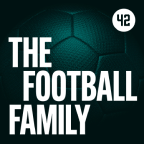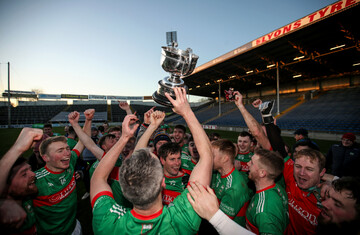UP UNTIL A few years ago, most of the players who were part of the last Loughmore-Castleiney team to reach Munster football final, were still alive.
But time has taken its toll more recently.
Just this year, they lost the leader of that 1973 team when captain Tom Hayes passed on at the end of October. There was a poignancy with the timing of his death. It was almost to the day of Loughmore-Castleiney’s anniversary marking their 2-10 to 0-7 victory over Ardfinnan to win the 1973 county championship, their first in 18 years. The final was on 21 October. Tom slipped away eight days later.
He was the latest, but not the only member of that team, to pass on. A celebration was held last year to mark the 50th anniversary of that team’s success. The surviving members toasted their absent friends, as memories of former glories were recounted of at the Templemore Arms hotel.
Some 51 years on from 1973, and Loughmore-Castleiney are on the verge of provincial glory again. A single strand connects this team with their heroes of the past through their captain Liam Treacy. His father John was part of the class of ’73, coming on as a sub in the county final. The mid Tipperary side picked up wins over Treaty Sarsfields of Limerick and Waterford outfit John Mitchells to earn a place in the Munster final where Cork’s UCC put an end to the odyssey with a six-point win.
The torch now passes to another group hoping to deliver a first Munster senior title for Loughmore-Castleiney. Their only disappointment is that it has taken this long to retrace their steps to this point. Many hurdles had to fall.
“A damning stat for the footballers,” says long-serving Loughmore-Castleiney member Tom McGrath. He comes from a family of local renown. His father Mick won a senior football title in 1955 with his brothers. Tom represented the name proudly alongside his own brothers when their turn came around. The current generation of McGraths are also carrying the family crest with distinction in both codes. Noel, John and Brian — nephews of Tom — are known more for their hurling achievements with Tipperary, but at home football is just as sacred to them.
“We wouldn’t have won that many football titles but the [semi-final] win against Éire Óg was our first win in Munster since 1979,” says Tom. “This was our eighth attempt. Our record in Munster wasn’t good and that’s something the lads were intent on rectifying this time. They had a clear month between the football final and the Ballygunner match and had time to think it out,” Tom McGrath says.
Loughmore and Castleiney are two separate parishes with about 18-20 townlands covering the entire area. The villages each have a pub and a church serving a population of around 950 people. The Loughmore and Castleiney National Schools are effectively GAA nurseries with passionate members of the club working the controls. The aforementioned John Treacy is a former principal in Castleiney while Stephen Maher was in charge in Loughmore. Maher didn’t play, but according to McGrath, he was an “organiser and a motivator”.
Over on the edge of the parish, near Thurles, another primary school has become a Loughmore-Castleiney feeder school. The current football manager Shane Hennessy is a familiar face in the halls.
“Shane Hennessy teaches in Leugh National School. Some of the lads went there because their parents and grandparents went there. Cumann na mBunscol is very strong in Tipperary. The football competitions are played before Christmas and hurling kicks in in March and April.”
Traditionally, Loughmore-Castleiney was known as a football club. Hurling always existed in pockets, but until the 60s and 70s, football was the dominant code. Socio economic changes in Ireland would contribute to the birth of a dual club.
“Our first year playing senior hurling would have been 1981,” McGrath recalls. “We won the intermediate championship in 1980 and we were playing junior hurling before that.
“The move to second level education and free education in the late 60s, an awful lot more people started going to secondary schools. There were two hurling schools then in Thurles CBS and Templemore CBS. That would have generated a bit of activity.
“We had 10 or 11 lads on the Templemore CBS team that won the Harty Cup in 1978. And when lads are successful in the schools, they’re moving on to county minor recognition, U21 and eventually on to senior. But you’d always have a spattering of lads on football teams and panels.”
Maintaining two codes in a rural GAA club is challenging. Thriving in both is remarkable. Loughmore-Castleiney has the second-highest number of senior county football titles with 16. Their hurlers have won five Tipperary senior championships, their first one coming eight years after securing promotion to the top tier in 1980. And this year, the club achieved a county double for the third time in 11 seasons.
Retaining numbers in a small population is critical, and challenges are always lurking. Restrictions on developing houses in rural areas presents difficulties for future generations of the club. But a plus for the current batch is the evolution of working from home policies post-Covid. Cutting down on commute times helps to keep players fresh amidst the demands.
The club has used innovative approaches to keep the air in tyres for both teams. They have to as everyone in the club tends to play both sports. Of the starting 15 who lined out in this year’s county football final against Clonmel Commercials, 14 played some part in the hurling final the previous Sunday. Some 11 started and three were introduced as subs in their victory over Toomevara.
Covering both football and hurling in one session helps avoid overtraining, and their conditioning is monitored by coach Paul Treacy.
“In different years, there would have been two distinct management teams,” McGrath explains. “And then around 2010, there was a merger of the team and a link established. Eventually, you had the one management team in charge of both. This year, it’s slightly different but the link is there as Shane Hennessy was a hurling selector as well. Mick Dempsey, Brian Cody’s former right hand man, is involved with the football. He’d have a very strong footballing background, but he’d know his hurling as well.
“He brings joviality to the team as well; he’s a bit of a character. There’s a serious side to him as well but when you’ve a lad who can bring the two things to it, it relieves tension as well.”
The club was one game short of contesting both Munster finals this year. Defending champions Ballygunner wrecked the narrative when they came away from Walsh Park with a 10-point win in the hurling semi-final. It should be noted however, that the Tipperary champions were afflicted by a stomach bug before that game, striking Brian McGrath first before his brother Noel then began experiencing symptoms.
Their camp was restored in time for their Munster SFC semi-final against Éire Óg, slamming two late goals through substitutes Ciarán Connolly and Philip O’Connell to march on. And now, the responsibility to deliver for the club rests on their shoulders.
They’ve encountered the might of Kerry’s Dr Crokes before. They’ve been drawn against them twice before in the Munster championship, losing out by six points in the 2016 semi-final. Their 2013 meeting was, as McGrath remembers, “a bit of a hammering.”
“We’ve the height of regard for them,” he adds. “A lot of household names. A lot of lads would have played against the Gooch and that was big stuff for them. You challenge yourself against the best and that’s what lads were doing. Crokes will be a tough nut on Sunday.”
Shortly before his passing, Tom Hayes was presented with the trophies from Loughmore-Castleiney’s double county success in 2024. The club’s latest generation of winners saluting one of the club’s greatest from the class of ’73. Another strand connecting the present with the past. History awaits on Sunday.
“There’s a big challenge ahead on Sunday and the experience they have in the team over the last number of years will be a help to them,” says McGrath. “They got a monkey off their back the last day and that’s that restriction gone. They’ll give it their best shot.”











Wenger says he hasn’t lost players, sounds like an Egyptian swimmer to me………in denial.
The delusion is amazing at this point.
Lol
I mean it’s not completely his fault the players are shite to be fair
@Conall Ó Briain: he bought the shite players . So yes it is completely his fault
@Shane Murphy: I wouldn’t say they’re shite players they are just playing shite. Sanchez and Ozil can be great
@Conall Ó Briain: Sanchez can, Ozil is a waster.
@David: Ozil is always the scapegoa for Arsenal. Goal and assist last week for him. Sanchez can be absent just as much as Ozil from games when he’s needed. The squad as a whole don’t have the fight in them
@David: scapegoat*
Sympathy and tactical advice from Big Sam.. thts a portent tht AWs time is done!
I could agree with you Arsene, but then we’d both be wrong.
Little Bo Peep , oh sorry they were sheep !!! Ferguson 8-2 , Jose 6-0 on 1000 match in charge , pep 5-1 in Allianz, Ancoletti 10-2 on aggregate , pulis 3-1 , fat sam 3-0 ,,koeman 4-0 pochetinno is sharpening his knife , 4 points from last 8 away games,how much humiliation can a manager and a club take
@ger gavin: That’s embarrassing, you’ve gone back quite a few years there to make an example. Most teams get a beating like that every now and again, not just Arsenal.
@ger gavin: up to date version: BAYERN 10-2 LIVERPOOL 3-1 WEST BROM 3-1
@Ollie Watson: i had the Pulis 3-1 , forgot the liverpool 5-1
@ger gavin: says the sad spud whose team last won a Title back when there wasn’t even colour photographs…1961…and who last won an FA Cup in 1991. Wenger has won 3 Premier Titles Spuds zero nil zilch nada…now get back in yr box spud.
Wonder who gets the chop first. Wenger or mourinho. Please God it’s the latter.
@BoomBoomBonnie: you hopefully!
@BoomBoomBonnie: of course you hope it Jose as your running scared of what he WILL achieve!!!
@BoomBoomBonnie: but your a Liverpool fan like me
@Mark Nugent: i hate choose. Tra la la la la
@Hoof Hearted: hahahhahahah tks for that
If Wenger had an ounce of sense he’d announce he’s leaving at the end of the season right now, that way he might actually get the team motivated again and his achievements would be lauded in the media.
Instead he’s going to go out in ridicule with a team and fans that are sick to death of him.